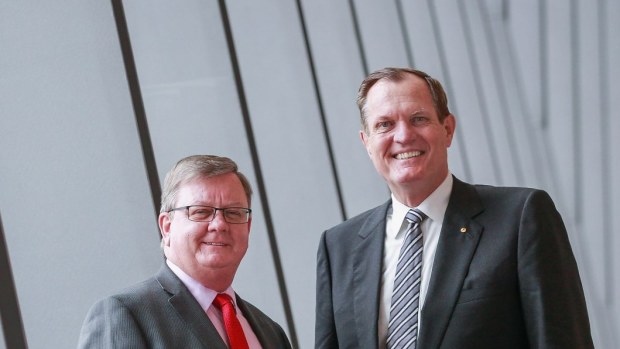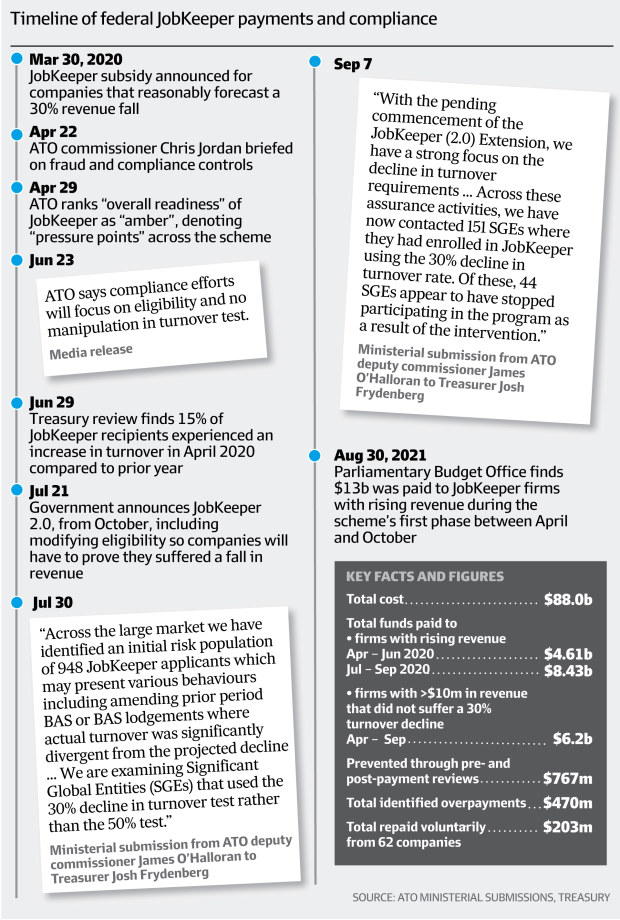Ralph Nader: While Americans Sleep, Our Corporate Overlords Make Progress Impossible
Politicians from both parties do the bidding of their corporate overlords rather than act on behalf of voters.
Federal treasurer warned in 2020 about the revenues of hundreds of big businesses claiming wage subsidy
Multinationals altered profits to claim JobKeeper
Treasurer Josh Frydenberg was warned last July that 1000 JobKeeper applicants with more than $250 million in turnover had booked revenue “significantly divergent” from forecasts of a downturn, while many were “amending” prior period sales figures to potentially gain eligibility to the program.
Just three months into the $90 billion wage subsidy program, the Australian Taxation Office also told Treasury it had found dozens of multinational organisations, known as significant global entities with more than $1 billion in yearly global revenue, that had won payments by using a 30 per cent decline in turnover test, rather than the required 50 per cent threshold.
ATO deputy commissioner James O’Halloran, who was in charge of the JobKeeper program, and ATO commissioner Chris Jordan. Wayne Taylor
A ministerial submission on July 30 from ATO deputy commissioner James O’Halloran is the first indication the agency was actively scrutinising possible “turnover manipulation” involving large corporations.
The agency had warned in June that it would be “assuring some of our largest JobKeeper payments”, by probing businesses that used incorrect turnover measurements and where actual revenues were “substantially greater” than the forecast declines used to meet eligibility rules for the program.
For the first phase of JobKeeper, which was introduced in late March 2020 amid the first wave of pandemic lockdowns and ran to October, JobKeeper applicants had to make a reasonable forecast they would suffer a 30 per cent fall in revenue compared to the same month, or quarter, a year earlier.
Charities were granted a lighter 15 per cent turnover decline test, while groups, or their subsidiaries, with aggregate revenues exceeding $1 billion had a 50 per cent hurdle. Only after October 2020 were payments restricted to firms that suffered an “actual” revenue decline, rather than a forecast.
The July update regarding the JobKeeper program reveals the ATO had only “early insights” into whether turnover forecasts were reasonable or compliant and was preparing to probe the issue more closely into the future.
“Some early insights into the turnover work include that a number of JobKeeper applicants have shown a fall in sales in the application month, but with subsequent months showing substantial increases,” the ATO said, according to documents obtained under Freedom of Information laws. “We will seek to obtain an understanding of both the drop in turnover and the increase in future periods.”
15pc enjoyed rise in turnover
The ATO note, which formed part of a regular monthly update to Treasury, shows the agency as early as July had found an “initial risk population of 948 JobKeeper applicants” each with turnover above $250 million a year that had amended legally required business activity statements (sales figures) from prior corresponding periods.
That may have indicated an intention to skirt around the turnover test, or where “actual turnover was significantly divergent from the projected decline”. In other words, where company revenues had confounded expectations and risen.
Although the ATO and Treasury had, by late May, access to private business activity data that showed 15 per cent of JobKeeper recipients enjoyed a rise in turnover in the first month of the program in April 2020, Treasury recommended in its three-month review of JobKeeper finalised in late June that eligibility should not be restricted to only companies that suffered “actual” declines in revenue for the coming three-month period between July and September.
Rather it supported a reassessment as to whether the program should introduce such rules from the start of October, when the JobKeeper scheme was extended. Only then did Treasury force applicants to prove they had suffered an actual turnover decline, rather than a projected fall.
Mr Frydenberg told the Financial Review that due to the extremely weak jobs market and soft economy in June last year, “Treasury’s advice was clear: ‘There are compelling arguments to maintain JobKeeper in its current form’.” He said the advice did not subsequently change.
“Treasury analysis has shown that 99 per cent of the businesses that did not experience the anticipated fall in turnover were small businesses, with an average of just four employees,” Mr Frydenberg said. “JobKeeper was a key part of the government’s economic plan to save jobs and keep businesses in business during the pandemic
The independent Parliamentary Budget Office in August this year identified $13 billion in JobKeeper payments to businesses that recorded increases in revenue during the COVID-19 crisis.
This was a cohort of 195,381 firms, the overwhelming majority of which were outside the large market focus of the ATO, that received JobKeeper payments but posted rises in business revenue during the first six months of the program last year.
While $4.61 billion was paid to 157,650 firms which recorded rises in revenue in the first three months of the program, the value of payments to firms posting increases in revenue almost doubled to $8.43 billion between July and September.
An ATO submission to the Treasurer in early September 2020 showed the revenue agency first prepared to pivot to a more compliance-driven administration of JobKeeper, outlining that “with the pending commencement of the JobKeeper (2.0) extension, we have a strong focus on the decline in turnover requirements
This memo also warned that significant global entities would be a target during the extension of the scheme. The ATO documents show it wrote to a raft of multinationals in September reminding them not to apply under the 30 per cent revenue decline threshold.
“Given the JobKeeper turnover test was based on a projection, we have not identified instances of deliberate manipulation of turnover. However, as we move into the JobKeeper 2.0 extension, these behaviours are likely to change,” the ATO said.
It noted that companies altering prior period sales figures was “a key behaviour associated with turnover manipulation” and that it had contacted 2200 companies that “amended the G1 (sales) label of their 2019 comparison period BAS (business activity statement) after the announcement of the JobKeeper 2.0 extension rules”.
Eligibility not aggressively policed
The ATO by December had found 23,000 companies that had tweaked pre-filled information sent to the agency in a move that gained the groups access to the payment whereas they otherwise would not have been eligible.
“For instance, based on the G1 (sales) disclosed on their Business Activity Statements, the decline in turnover was 29 per cent, however they have changed the pre-fill amount to report a 30 per cent decline
Turnover eligibility was not aggressively policed in the scheme’s first six-month phase. Rather, the ATO conducted a review that “focussed on public and private large organisations” which involved “profiling and contacting” firms considered a high-to-medium risk, while medium-to-low risk groups were handed “some level of generalised communication” that asked groups to “consider their eligibility” for the scheme.
Of more than 150 significant global entities that the ATO found had received JobKeeper using the wrong 30 per cent turnover decline threshold, a third, representing 1700 employees, stopped claiming the payment after being probed by the ATO. Only 19 multinationals repaid JobKeeper.
The ATO’s assurance program, aimed at the top end of publicly listed companies and which covered 46 per cent of all JobKeeper employees in ASX-listed firms, found only four companies were “not meeting” the turnover decline test by late August 2020, while another seven firms were “anticipated as not likely to meet the requirements”.
RELATED
JobKeeper largesse tops $13b
The ATO said that many of these large firms had made “reasonable projections, but actual decline did not eventuate”, that many were “severely impacted” by the government shutdowns at the start of the scheme but “rebounded quickly” in later months
However, the ATO’s assurance reviews were hamstrung by poor record keeping which was “found, in some instances, to not be up to the standard expected, particularly in the large market”.
“The overwhelming majority of entities reviewed for turnover risks have been eligible, with over 97 per cent eligibility rates,” the ATO said.
According to the documents, a subsequent review of 1800 JobKeeper applicants, including the 250 largest employers, the largest not-for-profit groups, and three quarters of the largest 500 private companies, found only 27 were ineligible, according to figures available in January 2021. This was mainly due to a company using a decline in turnover projection that “was not reasonable”, or because they had incorrectly applied the wrong turnover test.
ATO second commissioner Jeremy Hirschhorn recently told parliament the ATO’s “estimates are that the level of mis-claiming in this scheme was extremely low”.
Labor and crossbench senator Rex Patrick are pursuing a list of all firms that banked JobKeeper funds with a turnover of more than $10 million, which the ATO has fought on the grounds of taxpayer privacy.
JobKeeper lacked oversight body for five months
Australia’s single biggest public-spending program, JobKeeper, lacked a dedicated “oversight committee” of top executives that would escalate issues across government and raise concerns about contentious “trade-off” decisions, such as whether the scheme’s administration was “financially efficient”.
Such a committee was finally established five months after the launch of the $88 billion JobKeeper scheme, following a recommendation from an independent review of the wage subsidy program.
At the first meeting of the Australian Taxation Office’s stimulus measures oversight committee, top executives were warned of the need to “uplift” its ability to target risks across the COVID-19 stimulus programs. This included ensuring the “financial efficiency” of the scheme, that the latest data was being used to find and solve key issues, that problems were being escalated, and that the agency’s relationship and advocacy with Treasury was developed further.
Tax commissioner Chris Jordan. A PwC review found the JobKeeper oversight group had too many members and was not a “workable” size. Alex Ellinghausen
A confidential review of the Australian Taxation Office’s governance of the JobKeeper scheme in June 2020 by PwC recommended the agency set up the committee comprised of top bureaucrats to “strengthen accountabilities, distinction between roles, and reporting lines” after the consultancy interviewed senior executives responsible for the scheme.
According to the review, an oversight committee ought to have been set up at the start of the program but was “instead absorbed into the [lower level] program board to support the speed of delivering (JobKeeper) during implementation”
They JobKeeper program board was a body that functioned as an advisory group to the senior responsible officer for the program, ATO deputy commissioner James O’Halloran, who was also the chairman of the board. But the PwC review found the group had too many members and was not a “workable” size, with its membership constituted of four second commissioners, 13 deputy commissioners and 11 assistant commissioners, and a range of other secretariat and observers.
PwC said a separate and dedicated oversight committee, constituted mainly of top ATO executives, would be able to better provide “overall program assurance” and “built-in independent challenge” of the program’s administration. PwC argued this would allow “more focused information” to be considered and more “air time for the exploration of escalated risks and issues”.
Trade-offs had to be made between the timeliness of executing on each measure’s intent and better practice risk management.
— PwC report
While the ATO has acknowledged it prioritised getting money to applicants in the first six months of the program, internal documents show it began to consider moving to a more compliance-focused administration of JobKeeper when the scheme’s eligibility rules were tightened for the extension of the emergency payment from the start of October last year.
“The recommended accountability and governance structure are considered fit for purpose as the JobKeeper Program moves into its next phase, characterised by less change and at less speed,” notes the PwC review, which was obtained by The Australian Financial Review under Freedom of Information laws.
It recommended expanding such an oversight committee to all COVID-19 stimulus measures to “enhance the oversight and assurance” of all payments, which the ATO later adopted.
“An oversight committee has the necessary ‘air gap’ from the program to bring challenge to the risks and opportunities, including those on the horizon, and lift the conversation above the immediate delivery with consideration of the portfolio of COVID-19 stimulus measures, other ATO initiatives, and strategy,” PwC said.
PwC made its recommendations after consulting JobKeeper program board members, including second commissioners Jeremy Hirschhorn, Ramez Katf, Kirsten Fish and Jeremy Geal, along with the program’s senior responsible officer James O’Halloran, program lead Jason Lucchese and the ATO’s chief risk officer Ben Kelly.
Unprecedented pace
At a July 13, 2020, meeting of the ATO executive committee, Mr Kelly urged the creation of the oversight function across the portfolio of COVID-19 measures.
“An oversight committee was always intended to be a part of the JobKeeper governance structure,” notes a paper presented by Mr Kelly at the meeting. “Due to the unprecedented pace of this measure, decision-making and oversight has been amalgamated into the role of the SRO [senior responsible officer] and broader program board.”
While Mr Kelly at the time said the proposed committee would provide assurance of the program, it would also handle “contentious” key decisions.
“The oversight committee would include providing whole-of-agency strategic direction, advising on the alignment between program design and delivery with reference to the ATO’s strategic objectives and dealing with escalated, cross-agency and cross-government matters relating to JobKeeper,” he said.
The subsequently established ATO stimulus measures oversight committee held its first meeting on August 25, almost five months after the JobKeeper program was announced. It discussed a number of “opportunities for enhancement” and “uplift” across the agency’s administration, identified by a separate PwC review of all ATO stimulus programs.
“It was clear from the outset that trade-offs had to be made between the timeliness of executing on each measure’s intent and better practice risk management, especially for JobKeeper,” the PwC review noted.
“This was reflected in the risk appetite and tolerances set for each measure. It is acknowledged there is an opportunity to enhance how key decision makers and risk owners can readily obtain a concise and consolidated view of this information.
“From the experience to date, the trade-off has been supported, as evidenced through the lower fraud rates identified. However, it is recognised the measures’ delivery is a work in progress and will continue to be monitored and refined as more data is gathered.”
A review by the Australian National Audit Office of the ATO’s governance arrangements for the stimulus measures noted that the agency “undertook appropriate planning to support the rapid implementation of the six economic response measures” and that it focused on the “priority of implementing the measures in a timely manner, while also managing fraud and other integrity risks on a progressive basis”.
Although the JobKeeper scheme is credited with saving thousands of jobs during the COVID-19 crisis, the program has copped criticism after the independent Parliamentary Budget Office in August this year identified $13 billion in JobKeeper payments to businesses that recorded increases in revenue during the COVID-19 crisis.
This was a cohort of 195,381 firms that received JobKeeper payments but posted rises in business revenue during the first six months of the program last year. While $4.61 billion was paid to 157,650 firms which recorded rises in revenue in the first three months of the program, the value of payments to firms posting increases in revenue almost doubled to $8.43 billion to 195,381 companies between July and September.
RELATED
JobKeeper largesse tops $13b
For the first phase of JobKeeper, which was introduced in late March 2020 amid the first wave of pandemic lockdowns and ran to October, JobKeeper applicants had to make a reasonable forecast they would suffer a 30 per cent fall in revenue compared to the same month, or quarter, a year earlier. Charities were granted a lighter 15 per cent turnover decline test, while groups, or their subsidiaries, with aggregate revenues exceeding $1 billion had a 50 per cent hurdle.
Only after October 2020, when the JobKeeper 2.0 extension scheme was implemented, were payments restricted to firms that suffered an “actual” revenue decline, rather than a forecast.
ATO second commissioner Jeremy Hirschhorn recently told Parliament the ATO’s “estimates are that the level of mis-claiming in this scheme was extremely low”.
The ATO’s systems, which focused on pre- and post-payment reviews for entities deemed higher risk, probed 114,000 JobKeeper applicants, or close to 10 per cent of all applicants to the program. The process found about 30 per cent of these higher-risk entities were ineligible for the payment, and the agency prevented about $800 million from going out the door.
Its review of 480 large companies and multinationals found 95 per cent complied with requirements to make reasonable forecasts they would meet the decline in turnover threshhold.






